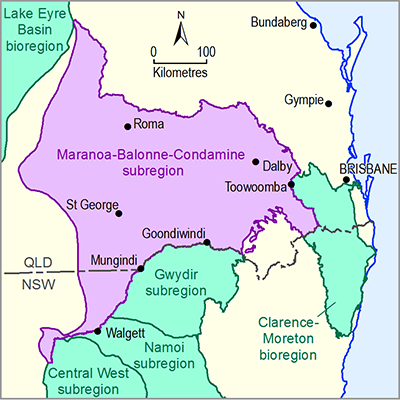- Home
- Assessments
- Bioregional Assessment Program
- Maranoa-Balonne-Condamine subregion
- 3-4 Impact and risk analysis for the Maranoa-Balonne-Condamine subregion
- 3.4 Impacts on and risks to landscape classes
The heterogeneous natural and human-modified ecosystems in the Maranoa-Balonne-Condamine subregion were classified into 34 landscape classes, which were aggregated into five landscape groups based on their likely response to hydrological changes. Landscapes that are outside the zone of potential hydrological change are very unlikely (less than 5% chance) to be impacted and include more than 35,000 km2 of the remnant vegetation, 59,000 km of the streams, 1,600 km2 of the wetlands and 93,000 km2 of productive landscapes within the assessment extent. The extent of landscape classes in the modelled open-cut mine pits is not reported in this analysis.
It is very unlikely that drawdown due to additional coal resource development exceeds 0.2 m in the source aquifers of the 177 springs in the assessment extent. This includes 153 springs that are hydrologically connected to Great Artesian Basin (GAB) aquifers and 24 springs that access non-GAB aquifers, such as the basalt aquifers of the Main Range Volcanics.
The extent of floodplain or lowland riverine landscapes in the zone of potential hydrological change includes 20 km2 of remnant vegetation and 299 km of streams, including riparian forests, marshes, billabongs, tree swamps, anabranches and overflows. Median additional drawdown is in addition to, and of a similar magnitude to, natural watertable fluctuation (<2 m).
The extent of GAB groundwater-dependent ecosystems (GDEs) in the zone includes 76 km2 of remnant vegetation and 319 km of streams that are hydrologically connected to GAB aquifers. None of the 153 springs that access GAB aquifers in the assessment extent are within 50 km of where there is at least a 5% chance of exceeding 0.2 m additional drawdown in the source aquifer identified for each spring. Median additional drawdown is in addition to, and of a similar magnitude to, natural watertable fluctuation (<2 m).
The extent of non-floodplain or upland riverine landscapes in the zone includes 12 km2 of remnant vegetation and 477 km of temporary upland streams. None of the 24 non-GAB springs that access the Main Range Volcanics basalt aquifers are in the zone. Local impact assessment and modelling is required to supplement regional groundwater model predictions of localised cumulative drawdown (<5 m) that may affect ecosystems dependent on permeable rock or basalt aquifers, including open woodlands with shrub and grass layers and stygofauna within the aquifer.
The extent of human-modified landscapes in the zone includes 685 km2 of land that is predominantly used for agricultural production, mining and urban development. Median additional drawdown in excess of 2 m may affect 92 km2, including 0.2 km2classified as ‘Intensive uses’ and ‘Production from irrigated agriculture and plantations’ that may be reliant on groundwater.
Users can visualise more detailed results for landscape classes using a map-based interface on the BA Explorer, available at www.bioregionalassessments.gov.au/explorer/MBC/landscapes.

Product Finalisation date
- 3.1 Overview
- 3.2 Methods
- 3.3 Potential hydrological changes
- 3.4 Impacts on and risks to landscape classes
- 3.4.1 Overview
- 3.4.2 Landscape classes that are unlikely to be impacted
- 3.4.3 'Floodplain or lowland riverine (including non-GAB GDEs)' landscape group
- 3.4.4 'GAB GDEs (riverine, springs, floodplain or non-floodplain)' landscape group
- 3.4.5 'Non-floodplain or upland riverine (including non-GAB GDEs)' landscape group
- 3.4.6 'Human-modified' landscape group
- References
- Datasets
- 3.5 Impacts on and risks to water-dependent assets
- 3.6 Commentary for coal resource developments that are not modelled
- 3.7 Conclusion
- Citation
- Acknowledgements
- Contributors to the Technical Programme
- About this technical product
